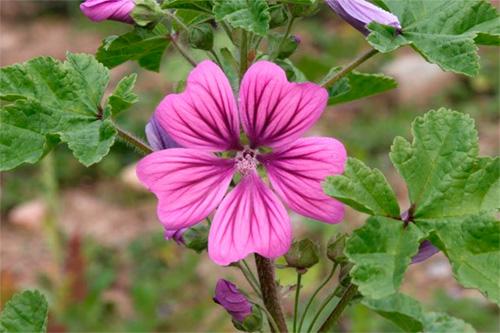Medicinal plants. Malva
Malva.
Malva parviflora L.
Name-s VULGAR-es: Malvilla minor
FAMILIA: Malva.CEAE
Some of the history of the plant:
Plant known since antiquity for its medicinal virtues, it was already used by the Greeks 2000 years ago. Hippocrates recommended it as emollient and laxative. Viera y Clavijo the quote in his work "Natural history of the Canary Islands:" well known it is, that the malva is reputed for the first of the four mucilaginous and emollient plants, sweeteners, laxatives and antinephritics; and that its flowers taken in infusion, soothe the thirst and favor expectoration ".
Description
Herbacea up to a little over half a metre high. Round, erect or staggered, hairy. Green leaves, also hairy above all through the top where the nerves, lobuled, stand out. Purple blue flowers with five petals. Round and depressed fruit formed by a set of fruit in the shape of a wheel.
Origin and ecology
Common and naturalized plant throughout Europe and America. Also naturalized in the Canary Islands where there are different species of this plant. Not threatened.
Location
It is found in low areas in humid fields and on island roads: L, F, C, T, P, G, H. Part used
The flower, and the leaves

Key active substances
Mucilages which by hydrolysis provide arabinose, glucose, ramnose, galactose and galacturonic acid.
Tannins
Anthocyanosides
Flavonoids
Sulphate components
How to program philips universal remote on sony TV?: its a philips universal remote model 2708 my remote stopped... Http: / / bit.ly
— Edd Smirnoff Wed Aug 10 03:56:52 +0000 2011
Vitamins A, B and C
Therapeutic properties and indications:
Derived from traditional use experience
"Mascated flowers serve to quench thirst. The whole plant boiled in water and black olives regulates intestinal functions and cures constipation. The infusion of leaves and flowers calms cough, colds, and throat inflammation. It is usually accompanied with honey of retama and, externally (cataplasms), it is good for the boils. " (Jaén Otero, José. 1984) .According to the content of active substances or pharmacological trials
The presence of emollient mucilages on the digestive and respiratory mucosa, and on the skin; the astringent action of tannins; anti-inflammatory and diuretic flavonoids; justify the popular uses of this plant in internal and external use: laxative, diuretic, antitusive, softener of throat inflammation, etc.
Derived from clinical trials
Endorsed by ESCOP or Commission E or WHO
Commission E of the German Ministry of Health approves the use of malva in infusion, for calming dry or irritating cough and for inflammation of the bucopharyngeal mucosa.
Adverse effects, incompatibilities and precautions
The presence of toxic nitrates in its composition tells us that we must be careful to take high doses of this plant. There are no empirical data or specific pharmacological or clinical studies on the toxicity of this plant. Follow the "fundamental precautions in the popular use of medicinal plants" indicated in the corresponding section of the chapter "Introduction and General".
Dose and form of administration infusion of 1 tablespoon of 5 ml dessert. = 2 grams. Of flowers and / or leaves of malva for a cup of water of 150 ml., let rest for 5 min. And filter. Take three times a day.
Examples of use
Decoction of leaves and flowers of mallet for external use:
In a liter of water, boil the plant at a rate of 30-50 grams / liter of water, for five minutes under low heat, let it rest for another ten minutes and filter or leak. This maple water or decoction is useful: in compresses on inflammation in the skin, or in eye washes in conjunctivitis or blepharitis, or in vaginal irrigation in vaginitis, rectal washings, etc.
This same decoction can also incorporate 30 grams. Of crushed flax seeds for the production of a plaster or cataplasm for the resolution of boils, abscesses or adenitis.
Decoction of leaves and flowers of malva and others for sores of the mouth
Following the same procedure, add sage leaves and summities, rim leaves and tail stalks. Once the resulting liquid has been washed or warm, we use it several times a day in the form of mouthrinds and / or gargarisms. In addition, we use the resulting liquid several times a day in the form of mouthrinds and / or gargarisms, following the same procedure.
Fresh plant juice for relief from insect bites
Extract the juice and apply it directly to the inflamed skin.









1611